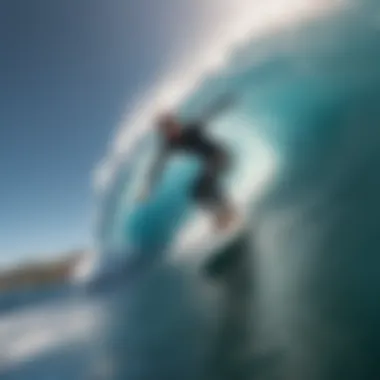Mastering Hang Ten Surfing: History and Technique


Intro
Hang ten surfing is a cherished maneuver within the world of surfing. It encapsulates not only a specific technique but also a rich history and culture. As surfers ride the waves, the essence of hang ten resonates through both physical skill and an appreciation of the ocean. This article aims to explore the intricate practice by shedding light on its historical significance, technical nuances, and cultural relevance.
Extreme Sport Overview
Hang ten is more than just a maneuver; it is a symbol of freedom and mastery over the waves. Surfers position themselves so that all ten toes are hanging off the front of the board, perfectly balanced while riding the wave.
The roots of this surfing technique trace back to the mid-20th century when surfing gained popularity in California and Hawaii. Pioneers of the sport, such as Bob Cooper and David Nuuhiwa, played key roles in its evolution, showcasing various styles and techniques that solidified hang ten into popular surfing culture.
Equipment required for hang ten surfing typically involves a longboard, which allows for stability and the necessary space to perform the maneuver. Longboards usually measure between 9 and 12 feet in length and offer the surface area needed for this type of riding.
For beginners, safety tips include wearing a leash to prevent the board from drifting away after a fall. It is also wise to use a wetsuit to protect against colder waters and make sure to choose waves suitable for your skill level.
Techniques and Training
Mastering hang ten requires practice and perseverance. A step-by-step guide includes:
- Choose Suitable Waves: Begin by selecting smaller, rolling waves that will provide a forgiving platform for practicing.
- Position Your Feet: As you catch the wave, shift your weight forward. Position your feet near the front of the board.
- Balance and Stance: Spread your legs slightly apart to maintain balance. Gradually slide your toes over the edge until all ten toes are extended beyond the board.
- Ride the Wave: Keep your core tight, and prepare for any shifts in the wave's motion.
For beginners, training tips involve practicing riding straight and staying centered before attempting the hang ten. Advanced surfers can focus on incorporating tricks, such as turns and rolls while hanging ten.
A workout routine to improve skills might include balance exercises, core strength workouts, and flexibility training. Incorporating surf-specific drills can help enhance your performance.
Notable Events and Competitions
Hang ten has seen its fair share of recognition in various surfing competitions. Events like the World Surf League often showcase athletes who can skillfully perform this maneuver. Competitors like Kelly Slater, who have embraced and popularized hang ten, have made a significant impact on the sport.
Profiles of top athletes highlight their dedication and skill. Recently, contests have seen rising stars making waves, further embedding hang ten into the fabric of competitive surfing.
Gear and Equipment Reviews
When exploring gear options, longboards are essential for hang ten surfing. Brands like Notox Surfboards and Surftech offer boards tailored for this purpose. Look for durability, weight, and buoyancy when selecting a longboard.
Pros and cons of popular longboards can include:
- Pros: increased stability, ease of catching waves, suitable for various skill levels.
- Cons: they can be heavy and cumbersome for newer surfers.
Recommendations for beginners may favor more stable boards like the Catch Surf Log while experienced surfers may prefer high-performance options like the Channel Islands.
Safety and Risk Management
Safety is paramount in extreme sports like hang ten surfing. Common risks include wipeouts, collisions with other surfers or marine life, and being caught in riptides. To mitigate these risks:
- Stay aware of your surroundings while surfing.
- Learn to spot riptides and avoid them.
- Always surf with a buddy for increased safety.
Emergency procedures should involve understanding how to signal for help and having a plan in case of rare accidents. Furthermore, consider insurance options that cover extreme sports, ensuring both peace of mind and protection.
"Surfing is not just a sport; it's a lifestyle that respects the ocean and its powers."
By understanding hang ten, enthusiasts can deepen their appreciation for the art of surfing. This comprehension transcends mere technique, embedding itself in the cultural and environmental aspects of surfing today.
Historical Background of Hang Ten Surfing
Understanding the historical context of hang ten surfing is vital to comprehend its influence on modern surfing culture. This section explores its origins, the introduction of the hang ten technique, and notable figures who played an essential role in its evolution. The importance of this background is not just about examining the past; it provides insight into how surfing has transformed into a respected sport and lifestyle today.
Origins of Surfing
Surfing has ancient roots. Historians trace its beginnings back to the Polynesian culture as early as the 12th century. In Hawaii, surfing was more than a recreational activity; it was a way to connect with nature and community. It involved various boards, made from solid wood and crafted distinctly for each individual. Surfing was a central part of life, showcasing bravery and skill.
The introduction of surfing to mainland America can be credited to Hawaiian princes in the early 20th century. Their visit sparked interest among Americans, leading to a growing surfing community along the Californian coast. This shift marked the beginning of what would become a revolutionary sport, laying the foundation for more intricate techniques, including the hang ten maneuver.
The Preamble of Hang Ten


The hang ten maneuver emerged in the 1960s, reflecting the surfing culture's evolution. It involves balancing on the front of the surfboard with all ten toes hanging off the board's nose. This technique not only demonstrates balance and skill but also redefines a surfer's style and presence on the wave.
Initially, this move required equipment that facilitated its execution. Longboards were essential because of their stability, allowing surfers to position themselves correctly. The 60s surf music and surf films showcased hang ten, embedding it in pop culture and further popularizing it among surfers.
Key Figures in the Evolution
Several surfers played fundamental roles during the rise of hang ten. Duke Kahanamoku, known as the father of modern surfing, popularized the sport internationally. He was not the only one; surfers like Tom Blake contributed to design innovations, revolutionizing surfboard shapes and materials.
In California, Greg Noll showcased aggressive riding styles, which altered perceptions about what surfing could be. As the hang ten maneuver gained recognition, other notable surfers such as Miki Dora and Skip Frye refined and promoted it. Their influence in the water and on the beach helped solidify hang ten's status, transforming it into an iconic aspect of surfing culture.
"Surfing is the most beautiful sport in the world. It's not just about riding waves, but about understanding yourself and nature." – Duke Kahanamoku
This section's exploration encapsulates the significance of hang ten surfing's historical backdrop. By grasping its origins, evolution, and those who shaped it, readers can appreciate its lasting impact on the surfing community today.
Technical Aspects of Hang Ten
The technical aspects of Hang Ten provide the framework essential for mastering this unique surfing maneuver. Understanding these components is crucial not only for performance but also for enhancing the riding experience. This section will cover the foundational knowledge, stance, and essential equipment associated with Hang Ten. All these elements combine to create a holistic approach to learning and executing the maneuver.
Understanding the Basics
Hang Ten is a specific surfing technique where a surfer positions both feet on the front of the board, allowing the toes to dangle over the edge. This maneuver symbolizes a high level of skill and control. To truly grasp Hang Ten, one must first understand the mechanics of wave riding. The surfer must have a solid foundation in basic surfing skills, which includes paddling, catching waves, and maintaining balance.
When learning Hang Ten, it is also important to recognize wave conditions. Surfers benefit from riding glassy and mellow waves, as they provide a stable platform for achieving the required stance. This knowledge can assist the surfer in selecting the right time and place to practice Hang Ten, ultimately enhancing their skill level.
The Balance and Stance
Mastering balance and stance is imperative in successful execution of Hang Ten. A surfer’s center of gravity must be lowered and aligned over the board’s axis. Proper foot placement significantly affects balance. The front foot should be positioned near the nose of the board, while the back foot remains near the tail for control.
Surfers should also focus on their body positioning in relation to the wave. Leaning forward slightly can generate speed, while leaning back helps maintain control.
"Maintaining a good stance and balance is crucial to keeping the momentum during the Hang Ten maneuver."
Practicing drills that involve shifting weight can help develop this essential skill. Exercises both on land and in the water can significantly improve balance for this technique.
Required Equipment
Appropriate equipment plays a significant role in performing Hang Ten. Selecting the right surfboard is crucial. Boards that are slightly longer and wider tend to work best for this maneuver as they provide better stability. A fish or longboard design is often preferred by many surfers because they allow for easier balancing and foot placement.
Additionally, the condition of the surfboard is important. Ensuring that the board is well-maintained with no damages or worn areas can enhance performance. Surfers should also consider using a leash to prevent losing the board during the practice.
For those looking to analyze performance more seriously, equipment like body cameras or drones can offer valuable insights into technique and execution. Monitoring foot positioning and overall body movement can provide critical feedback.
Lastly, wearing the right attire contributes to comfort. Choosing suitable wetsuits or rash guards can enhance flexibility and prevent irritation while surfing.
In summary, comprehending and mastering these technical aspects of Hang Ten is essential for any surfer. From understanding the foundational basics to focusing on balance through equipment choice, each element plays a vital role in achieving this iconic maneuver.
Biomechanics of Hang Ten
The biomechanics of hang ten surfing is crucial for understanding how this iconic maneuver is performed effectively. Delving into the physical aspects provides insights into body movement, weight distribution, and control, which are essential for both safety and performance. By analyzing these elements, surfers can enhance their skills while minimizing injury risks. The intricacies of body mechanics allow surfers to optimize their techniques, ultimately fostering a deeper connection with the sport.
Body Movements Required
Successful execution of the hang ten relies heavily on specific body movements. Firstly, proper positioning is essential. Surfers must bend their knees slightly and lower their center of gravity, which improves balance. The arms play a vital role in maintaining equilibrium; they should remain relaxed and extend naturally.
The most notable movement is the transition to "hang ten," where both toes are placed over the nose of the board. This shift requires engaging core muscles. Core strength helps maintain stability while shifting weight forward. Additionally, quick foot adjustments might be necessary to respond to the board's reaction due to wave forces.
Weight Distribution Techniques
Effective weight distribution determines the success of the hang ten maneuver. Surfers should focus on even weight distribution across their feet. Ideally, weight might slightly favor the front foot when preparing to hang ten; this positions the surfer for balance as they shift their footing.
Another technique involves adjusting body angles during the maneuver. Leaning forward can help maintain control over the board while the back foot is used for steering. Learning to shift weight effectively between feet aids in navigating tricky wave conditions. Surfers must be aware of their body alignment; improper alignment can lead to loss of balance.
Acquiring Speed and Control


Acquiring speed while performing hang ten is critical for maintaining control on the wave. Surfers can increase speed by paddling effectively before standing. Once on the board, they should use their legs to generate additional energy by bending and extending their knees rhythmically.
Additionally, the timing of weight shifts during the ride enhances control. Timing refers to how body movements correspond with wave patterns. Mastering this timing requires practice and observation of wave dynamics. Surfers can also use bottom turns to gain momentum before transitioning to hang ten. With practice, surfers can refine their technique, ultimately improving both speed and control.
A thorough understanding of biomechanics can propel a surfer’s performance, enabling them to master the complexities of hang ten surfing.
The knowledge of biomechanics is not only about improving performance; it also fosters a greater appreciation for the physicality of surfing. Knowing how to align body movements, distribute weight properly, and generate speed can profoundly influence a surfer's journey, enabling them to meet the challenges of this exhilarating sport.
Cultural Impact of Hang Ten Surfing
The concept of hang ten surfing extends far beyond the act of riding waves. Its cultural significance infiltrates various aspects of life, influencing media, fashion, community relations, and even environmental consciousness. Understanding its cultural impact allows surfers and enthusiasts to appreciate not only the craft but also the lifestyle and mindset associated with it. The hang ten maneuver has become a symbol of freedom and expression within surf culture, embodying a spirit that is influential on and off the water.
Representation in Media
Hang ten surfing has notably found its place in various media forms, ranging from films to music videos. Documentaries and surf films often highlight the aesthetics and thrill of surfing, with the hang ten maneuver being a focal point that captures audiences. Movies like "Endless Summer" and countless surf documentaries have created a nostalgic aura, celebrating the timeless nature of this skill.
Hang ten surfing's portrayal in media shapes public perception, depicting it as an exhilarating yet serene activity.
These representations not only inform the general public about the sport but also affect those within the surfing community. They glorify certain styles and practices, encouraging new generations to take up surfing and explore hang ten. As a result, this interest can lead to increased participation in surf culture, nourishing local surf economies and fostering community ties.
Influence on Fashion and Lifestyle
The essence of hang ten surfing transcends the water and permeates fashion. Brands like Quiksilver and Billabong have historically drawn inspiration from the surfing lifestyle, producing clothing that resonates with the spirit of the surf community. The trend toward casual, relaxed styles of attire, such as board shorts and loose-fitting shirts, can be traced back to this influence. Moreover, the unique designs often showcase waves and surf culture, creating an identity closely tied to the ocean.
In lifestyle terms, many who embrace hang ten surfing adopt a more laid-back approach to life. The elements of freedom, adventure, and connection with nature become central to personal values. This lifestyle signifies a departure from the mainstream, promoting sustainability and environmental awareness that is essential for surfers today.
The Global Surf Community
The practice of hang ten surfing has contributed to forming a global surf community. This community celebrates diversity, as surfers from different backgrounds come together driven by their love for the ocean. Nationalities and languages may differ, but the experience of riding waves unites them.
Surf competitions often spotlight the hang ten maneuver, showcasing it as a critical skill. These events allow surfers to exchange techniques and deepen connections, creating bonds among participants. Furthermore, the increasing popularity of surf culture globally leads to collaborative efforts aimed at maintaining surf spots and protecting the marine environment.
Challenges Faced by Surfers Today
The modern surfing world is dynamic yet turbulent, confronted by several challenges that affect both recreational and professional surfers. As the sport grows, so do the threats to its practice and culture. Addressing these challenges is crucial for sustaining the essence of surfing. Through understanding these elements, surfers can better prepare and adapt to new situations, ensuring the future of hang ten and the broader surfing community remains vibrant.
Environmental Concerns
Environmental issues pose significant challenges to surfers. Climate change is one pressing factor. Rising sea temperatures and changing weather patterns affect wave quality and surf conditions. Additionally, ocean pollution is a significant concern. Chemicals and plastics pollute waters and damage marine life. Surfers face the reality that the very beaches they love may no longer be pristine and inviting. Protecting these natural resources is essential for the future of surfing itself.
"Surfers are often the first to notice ocean changes, and their role in environmental activism is pivotal."
Surfers can engage in various initiatives. These include beach clean-ups and advocacy for policy changes aimed at environmental protection. More awareness about what contributes to pollution can lead to behaviors that benefit both surfers and the ocean.
Access to Surfing Locations
Access to surfing locations continues to shrink due to several factors. Urban development encroaches on natural beaches, reducing public access. In many regions, exclusive beach clubs restrict entry for surfers. These restrictions raise significant concerns around the future accessibility of vital surf spots. Local surfers often feel disenfranchised by the trends commercializing what once was common surf culture.
Another issue is the rising popularity of surfing tourism. While it can boost local economies, it often results in overcrowded breaks. This situation can lead to increased conflicts between novice and seasoned surfers. Maintaining equitable access for all surfers ensures that the sport remains inclusive and robust.
Safety Considerations
Safety is a fundamental issue that surfers cannot overlook. With more surfers in the water, the risk of accidents increases. Collisions between surfers are common, especially in crowded spots. Moreover, changing wave conditions can lead to dangerous situations. New surfers may lack the experience to navigate challenging waters safely, resulting in unfortunate incidents.
Surfers must prioritize safety by wearing appropriate gear, such as leashes or rash guards, and understanding local conditions. Educating new surfers through awareness programs or surf schools can help mitigate these risks. Ultimately, fostering a strong culture of safety encourages a healthier surfing environment for everyone.
The Art of Learning Hang Ten
Learning the art of hang ten is crucial for any surfer looking to elevate their skills. Mastering this maneuver involves not just physical capability but also a deep understanding of surfing techniques and culture. Here, we will explore significant aspects like mentorship, practice routines, and goal-setting that accompany the journey to hang ten.
Finding the Right Mentor
A good mentor can be the difference between struggling through the learning process and quickly grasping hang ten techniques. They should have significant experience and knowledge of surfing. A mentor can provide individualized feedback, demonstrate techniques, and instill confidence in a beginner. When looking for a mentor, consider the following factors:


- Experience Level: Look for someone with a proven track record in surfing and specifically in performing hang ten.
- Teaching Style: Ensure their approach to teaching aligns with your learning style. Some may be more hands-on, while others prefer a more analytical approach.
- Availability: A good mentor should be approachable and willing to dedicate time to guide you.
Having supportive guidance will lay a foundation for success.
Practice Techniques and Drills
To thrive in hang ten surfing, dedicated practice is necessary. Here are some techniques and drills that can enhance your skills:
- Balance Drills: Use a balance board or practice on soft surfaces to improve stability. This simulates the conditions on a surfboard.
- Stance Training: Spend time in the water adopting the hang ten position. Practice shifting your weight as you ride.
- Paddling Technique: Ensure effective paddling. Being in the right position before attempting to hang ten is crucial.
- Foot Placement Practice: Learn where to place your feet on the board for optimal control. Experiment with foot positions on flat ground before doing it in the water.
Commitment to these drills will develop muscle memory and confidence when you are on the waves.
Setting Realistic Goals
Goal setting is an essential part of learning to hang ten. It keeps the process structured and focused. Here’s how to set realistic, achievable goals:
- Short-Term Goals: Start with smaller, achievable goals, such as successfully maintaining balance for a few seconds. Minimize frustration and build confidence.
- Mid-Term Goals: Aim to incorporate hang ten into your regular surfing routine. Focus on consistency and technique during each outing.
- Long-Term Goals: Work towards integrating hang ten into various wave conditions and during competitions if applicable.
Remember: Adjust goals based on your progress. This reflects changes in learning pace and capabilities. Regularly reviewing and updating goals helps track development and maintain motivation.
"Setting specific, measurable goals allows surfers to gauge their progress and enhances commitment to learning."
Each of these sections lays a pathway to mastering hang ten surfing. Dedicating effort to finding a mentor, practicing effectively, and setting clear goals shapes not only the skills but also the art of hang ten itself.
Future of Hang Ten Surfing
The future of hang ten surfing remains a fascinating topic in extreme sports. It reflects both the evolution of styles and influences affecting this classic maneuver. The art of hang ten is not just about balancing on the nose of the board; it intertwines with technological advancements and competitive arenas that shape how surfers practice and showcase their skills. Exploring these elements contributes to a richer understanding of where hang ten surfing is headed.
Evolving Styles and Trends
Over time, surfing styles evolve through cultural shifts and personal expression. New trends often emerge within the surfing community, pushing traditional boundaries. Today, the hang ten maneuver is being reinterpreted by surfers who incorporate creative flair into its execution. Techniques such as cross-stepping and dynamic fluidity are becoming more common, with surfers experimenting with how they approach the wave.
Additionally, the influence of social media has played a pivotal role. Surfers share videos of their tricks, inspiring others to innovate and take risks. As various subcultures within surfing gain popularity, such as longboarding and alternative board shapes, hang ten is adapted to fit these styles. This makes the future of hang ten an exciting prospect, driven by individual interpretation and a communal spirit.
Technological Advancements
The evolution of equipment directly impacts the hang ten experience. Innovations in surfboard design enhance performance, allowing surfers to reach new heights in their maneuvers. Improved materials make boards lighter and more responsive, elevating the overall surfing experience. For example, boards utilizing EPS foam and epoxy resin showcase increased buoyancy and durability.
Moreover, digital technology has revolutionized how surfers analyze their performances. Tools such as drone footage and wearable tech provide insights into technique and body position, offering feedback for improvement. This data-driven approach helps surfers refine their hang ten execution, ensuring that they remain at the forefront of the sport.
Role of Competitions
Competitions play a crucial role in the progression of hang ten surfing. Events increasingly feature categories that highlight specific maneuvers, allowing surfers to showcase their skill in hang ten alongside other techniques. High-profile competitions, such as the Vans US Open of Surfing, provide a platform for surfers to gain recognition and showcase their talent globally.
These competitive environments not only encourage excellence but also foster camaraderie among participants. Surfers learn from one another, exchanging ideas and techniques that ultimately drive the evolution of the sport. Engaging with competitions can serve as a motivator for surfers who wish to master hang ten, pushing them to hone their skills relentlessly while contributing to the rich tapestry of surf culture.
"The future of hang ten surfing holds infinite possibilities, driven by creativity, technology, and competition."
End
The conclusion of this article on Hang Ten surfing serves as a crucial summary that ties together the essential elements discussed throughout. Hang Ten is not merely a surfing maneuver; it embodies a historical journey that intertwines culture, technique, and environmental awareness. The importance of understanding this concept lies in its multifaceted nature, encompassing not only the physical techniques involved but also the cultural significance and the evolving landscape of surfing today.
Recap of Key Points
The discussion of Hang Ten has highlighted several key aspects that are vital for the reader's comprehension:
- Historical Significance: From its origins in the 1960s to its representation in modern media, Hang Ten has shaped and defined surfing culture.
- Technical Skills: Mastering Hang Ten requires an in-depth understanding of balance, body movements, and necessary equipment.
- Cultural Impact: Hang Ten has influenced fashion and lifestyle within the surf community while promoting a sense of unity among surfers worldwide.
- Environmental Considerations: Present-day surfers face significant challenges such as pollution and access to clean surf spots, which cannot be ignored.
Through these points, we have examined how Hang Ten surfing reflects broader societal values and challenges that surfers encounter in their environment.
Final Thoughts on Hang Ten Surfing
In closing, Hang Ten surfing is much more than a technique; it represents a way of life for many. As surfing continues to evolve, it is vital for new generations to appreciate the roots and advancements of this art form. The knowledge gained here not only equips surfers with skills but also fosters a deeper connection to the ocean and the communities that surround it.
Therefore, as enthusiasts indulge in this thrilling sport, let them remember the implications of their actions on the world. Hang Ten is an enduring symbol of surf history, and its future will depend on how it adapts to changing tides, both in and out of the water.
"To surf is to embrace freedom and exhibit creativity; Hang Ten is a testament to that spirit."
In essence, understanding the nuances of Hang Ten encourages respect for the ocean and the sport itself.

